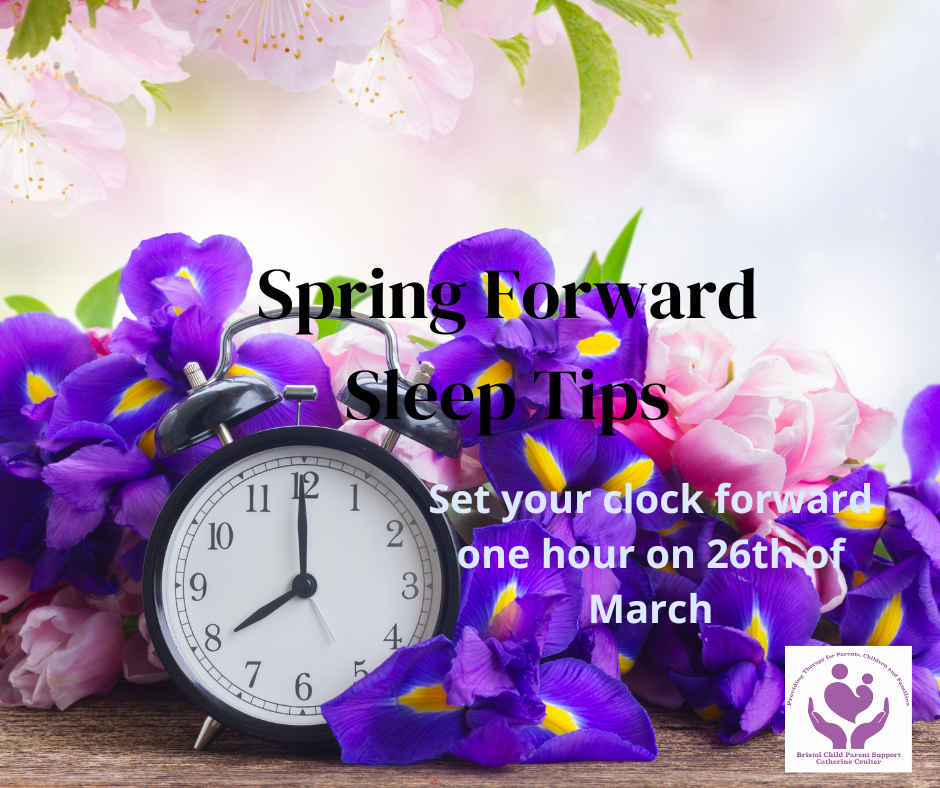The clocks will go forward one hour on Sunday, March 26th, at 1 am.
This means we all lose an hour. To remember which direction to change the clocks, there is a simple old saying to memorise: ‘spring forward, fall back’. A good night’s sleep is essential at this time. It’s one of the best ways to remain healthy and manage anxiety. Here are my sleep tips for Spring forward and for parents whose children are also anxious at night.
Why having a good night’s sleep is so important now?
It’s been a long old winter with cold and windy weather. March is upon us, meaning Spring, new life, and longer days.
It’s an excellent time to remember that one of the best ways to maintain a robust immune system is to get a good night’s sleep. (There’s a lot of complicated-sounding science behind why this is, but it has to do with “T-cells” being better able to fight infected cells when stress hormones are low. Stress hormones are at their lowest when we are asleep)!
This is a talk I offered in lockdown with lots of tips and information to help everyone have a good night’s sleep.
How does Daylight Saving affect all of us?
Daylight Saving and how it affects Adult Sleep.
Even though we only lose an hour of sleep, if you are already sleep deprived, this will hurt. According to the National Sleep Foundation, it may even make us feel as if we are slightly jet-lagged for the first week. That’s all everybody needs right now!
Your body’s internal clock (or circadian rhythm) may be thrown off course, affecting how much sleep-inducing melatonin is released and when. Most of us work on screens (exposed to blue light) most of the day. This impacts our capacity to absorb melatonin. You can find out further information on how to limit blue light at my blog here:https://bristolchildparentsupport.co.uk/how-to-limit-exposure-toblue-light-and-improve-family-sleep/
Tips to help adults and Teenagers Now
Additionally, always get up with day, even though you or your teenager may want to lie in bed.
You or your teenager may benefit from a nap but ensure it’s no longer than 20 minutes; otherwise, you cannot sleep later.
Expose yourself to sunlight in the morning.

Gradually wake up; if you are an owl; waking up an hour earlier may hurt. I recommend leaving your clocks alone Saturday night so that it is not as much of a shock to the body when you open your eyes to look at your clock upon waking up Sunday morning. Instead, wake up Sunday morning, have breakfast, and then change your clocks around your house. Psychologically, waiting until Sunday morning to change the time will feel much better for everyone.

Daylight Saving Sleep Tips for children.
Darken Up the Room.
You can also darken your child’s room when the sun rises early or sets late to prevent the sun from peeping through during the early morning hours. With the sun rising so early in the morning, your child may wake up too early and struggle to fall back asleep. Keeping their room dark helps signal their bodies that it is still time to sleep. In addition to this change, bedtimes will occur while it is light outside. Therefore, darkening the room can significantly increase melatonin levels at rest, allowing your little one to sleep better.
Adjust Sleep Times.
You can try putting your child to bed five to 15 minutes earlier every few days leading up to the start of daylight savings time. By the time you move the clock forward an hour, your child will already be used to going to bed at an “earlier” time.
For school-aged children, avoid naps.
Many parents make the mistake of allowing their child to nap during the day following daylight-saving. DONT, your child may not be sleepy at bedtime.
Sleep and Anxiety.
With global events adding to this stress, there is still much fear. Fears may be located in sleep disturbances. The amygdala — a brain region that processes emotional events — becomes overactive when you are tired. You might notice your child may show:
- Difficulty in falling asleep
- Resistance to going, delaying going to bed
- Clinginess and more night awakenings, nightmares
Researchers have found that the type of sleep most apt to calm and reset the anxious brain is deep sleep, also known as non-rapid eye movement (NREM) slow-wave sleep, in which neural oscillations become highly synchronised and heart rates and blood pressure drop. The findings, published in Nature Human Behaviour, provide one of the most robust neural links between sleep and anxiety.
Many parents feel trapped at bedtime, caught between a healthy desire to help their child settle to sleep peacefully and a genuine need for some alone time to refuel. Choose the first option, and often your window of alone time disappears. Choose the second, and your heart breaks as you try to ignore your child’s pleas for comfort. There is another way you can address your child’s fears.
Sleep training/relearning alone does not address your child’s fears. This is why it can be ineffective.! This is why I work with helping you and your child manage the fears first, and then we can do sleep training safely.
Ideas to manage the Nighttime Fears
What are Nighttime Fears?
Nighttime fears are common in children and are a normal part of child development. Nighttime fears are normal reactions to real or imagined threats at night, including fear of monsters, ghosts, burglars, animals, and fear of the dark. Sometimes they include fear of bad dreams.
What’s normal?
It is usual for children between the ages of two and nine to experience nighttime fears. These are the years when your child’s powers of imagination are growing. It means they can now imagine new and scary things to be afraid of. They can’t distinguish between fact and fantasy; it can be hard for them to shut off thier imagination at bedtime and go to sleep.
For example, an old pile of clothes on the floor may look like a real ghost or monster to a child.
How would I know my child might be anxious or have Nighttime fears?
Children with Nighttime fears use various coping strategies to reduce such fears. Children seek parental support to ease their nighttime fears. They may want you to remain in their bedroom or upstairs until they sleep, as they are too scared to be alone. Often, children present as agitated, coming out of their room and downstairs several times a night.
It is common for children to engage in “stalling behaviour.” They may take a long time in the bath or refuse to brush their teeth. A noise may cause them to call you back in. They may suddenly be hungry or need a drink just as they go upstairs.
There may be some safety behaviours they exhibit.
You may need to check under their beds or in their wardrobes. Each night, they may have their teddies or room arranged in a specific way. You may be asked to lock all the doors. These behaviours are called safety behaviours. Additionally, your child may want you to stay in their bedroom until they fall asleep.
Refrain from “crying it out.”
Children need assistance and a calm adult or carer to manage their fears. Often I write about a child’s developing brain and how they are learning self-control and self-regulation. Leaving your child alone with “the worry” will escalate their sense of being unsafe, and it will take longer for them to fall asleep.
Teach your child to relax and be calm.
You can calm your child in many ways. Children of all ages will benefit from massages. Massage releases our calm chemical Oxytocin. Include massage in your bedtime routine. Record a lullaby in your voice and play it through the night. Help your children to learn how to breathe by blowing bubbles or doing tummy breathing. Older children can learn mindfulness.
A sleep meditation helps them to know it is safe to let go.
Talk to them that it is normal to be scared of the dark, ghosts, etc.
Often, children feel that they are the only ones who are scared. It is usual for children to feel this way, so tell them it is common for them to feel this way and show them there is no monster in the closet.
Teach self-talk: Help them to manage” the worry monster.“
Identify it as the “worry monster”. Help them take control of the situation. You can then help them think of images that make them feel in control, safe, and calm. You can use my safe place exercise here or create one of your own.
Have a consistent Bedtime routine.
Evidence shows that consistency is going to help with sleep difficulties. A simple bedtime routine of bathing, teeth brushing, story, and hugging shouldn’t take more than 40 minutes. Children who are worried tend to stall. This can happen as soon as you climb up the stairs. Children can start feeling anxious about bedtime an hour before the bedtime routine. Take your time and be gentle with them. You may need a therapist to facilitate this process.
Tend to Nightmares quickly.
If your child is suffering from nightmares, respond, and reassure quickly. Please don’t leave them alone to work it out for themselves. For more on how to manage nightmares, here>> nightmares and night terrors<<
In Conclusion.
All the evidence supports that making a regular sleep routine with consistent wake time and exposure to sunlight is a potent combination for healthy sleep. If your child is anxious, read the blogs below for more information on sleep and anxiety. Stay safe and well during this time.
Related Posts
Back to school sleep readjustment
How to talk to your child about anxiety
Does my child suffer from separation anxiety
Back to School Anxiety during the Pandemic.
Recognising Anxiety in Children.
Helping you and your Child Manage Transitions.
Thank you for taking the time to read this and for your commitment to the well-being of your child and family. Also, your willingness to keep growing and holding hope. Remember: parenting is hard work, and you all deserve support. And when it all starts to feel impossible, ask for help. If you need help and support, contact me for a consultation or do join my newsletter community.



